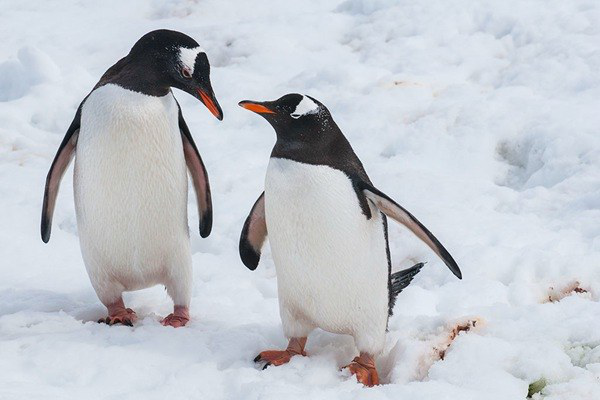Pygoscelis papua
IUCN
LCBasic Information
Scientific classification
- name:Pygoscelis papua
- Scientific Name:White-browed penguin, Gentleman penguin, Gentleman penguin
- Outline:Waterfowl
- Family:Sphenisciformes Spheniscidae Pygoscelis
Vital signs
- length:75-90 cm
- Weight:5.5-6kg
- lifetime:13 years (in the wild), 10.5 years (in captivity)
Feature
The Gentoo penguin is the fastest swimmer in the penguin family and can swim at speeds of up to 36 kilometers per hour.
Distribution and Habitat
Distributed in Antarctica, Argentina, Chile, the Malvinas Islands, Heard Island, McDonald Islands, South Georgia Island and South Sandwich Islands.
Migrant bird: Australia, New Zealand, St. Helena Island, Ascension Island, Tristan da Cunha Islands, South Africa.
Origin uncertain: Bouvet Island, Antarctic continent, Antarctic Peninsula, and several islands such as South Shetland Islands and South Georgia Island.
Inhabits the Antarctic Peninsula and islands in the Southern Ocean. Forages in the South Atlantic Ocean, with a large number in the Malvinas Islands (also known as the Falkland Islands). The Malvinas Islands have an average annual temperature of 5 degrees Celsius, making it a paradise for cold-resistant wildlife, where a large number of penguins live freely.
Appearance
The Papua penguin is the largest penguin species after the emperor penguin and the king penguin. It is 75-90 cm long and weighs 5.5-6 kg. It has an orange-red beak and webbed feet, and a wide white stripe on the top of its head.
The adult Papua penguin has black feathers on its back and a white belly, while the young penguin has a gray back. The adult Papua penguin has a distinct white spot above its eyes, a slender beak, red corners of its mouth, and a red triangle at the corner of its eyes, which makes it look handsome. Because of its cute and naive appearance, it is like a gentleman, so it is commonly known as the "gentleman penguin". The young penguin has a gray back and a white belly, which is very similar to the adult penguin. The difference is that the young penguin does not have a white spot above its eyes until they have completed their molting at 14 months old.
The webbed feet of the Papua penguin are orange and have long black claws. The color of the beak ext
Details
The Gentoo penguin walks on land with a shaky gait, and its long tail swings left and right behind it like sweeping the ground, so its scientific name is "Pygoscelis", which means "broom-like tail".

The Gentoo penguin is one of the three members of the genus Pygoscelis. Mitochondrial and nuclear DNA evidence shows that the Adélie penguin genus began to branch off from other penguin groups about 2 million years ago, after the king penguin genus (Aptenodytes) branched off from other penguin groups about 40 million years ago. After that, the Adélie penguins also split off until about 19 million years ago, while the chinstrap penguins and gentoo penguins did not split off until 14 million years ago.
The gentoo penguins have poor vision on land, but when they are underwater, their retinas are very sensitive and can clearly distinguish green, blue and purple.
Gentoo penguins live in the cold Antarctic, with no fresh water to replenish, and their food has a high salt content. In order to maintain the balance of electrolytes in the body, Gentoo penguins, like other seabirds, have salt glands above their eye sockets, which discharge excess salt in the form of mucus from the nostrils above the beak.
If food is insufficient, the second hatched penguin will usually starve to death. The young birds molt twice (which is unique among birds).
In the water, sea lions, seals and killer whales are all natural enemies of Gentoo penguins. On land, adult Gentoo penguins are not threatened, but birds, such as skuas, will steal their eggs and young penguins. There are approximately 630,000 Papua penguins. The species is listed as Near Threatened because, although some populations have increased significantly, some key populations have declined rapidly, resulting in a rapid decline in the global population.
In addition, the collection of penguin eggs, the increasing oil extraction in the Falkland Islands, maritime transportation that affects the penguins' foraging, and tourists' sightseeing that interferes with penguin reproduction all pose a threat to their survival and reduce the reproduction rate of Papua penguins.
Listed in the 2012 IUCN Red List of Threatened Species ver3.1 - Near Threatened (NT).
Listed in the IUCN Red List of Near Threatened Species - Least Concern (LC).
Protect wild animals and stop eating game.
Maintaining ecological balance is everyone's responsibility!








